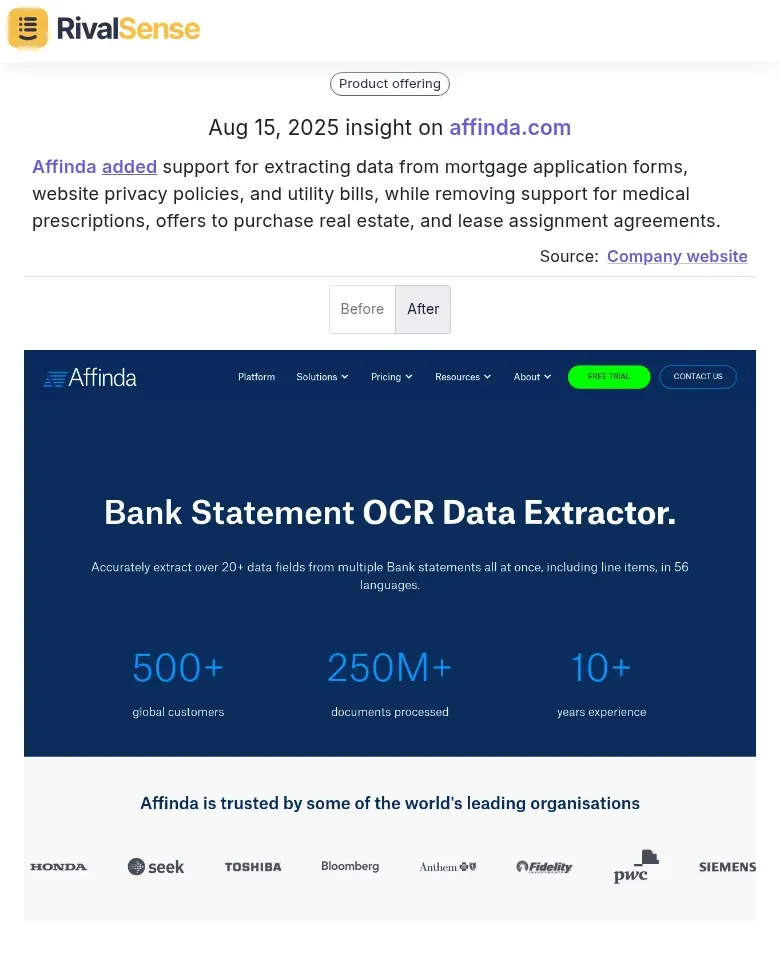Competitor Website Teardown Techniques: A Step-by-Step Guide for B2B Leaders
Understanding your competitors' online presence is crucial for staying ahead in the market. A competitor website teardown allows you to dissect their digital strategy, uncover insights, and identify opportunities to differentiate your brand. In this guide, we’ll walk you through a step-by-step process to conduct a thorough competitor website analysis, complete with practical techniques and tools like RivalSense to streamline your research.
WHAT IS A COMPETITOR WEBSITE TEARDOWN?
A competitor website teardown is a deep dive into a competitor’s website to analyze its structure, content, user experience, and marketing strategies. This process helps you understand their strengths and weaknesses while uncovering gaps in your own strategy. By systematically evaluating their digital footprint, you gain actionable intelligence to refine your market positioning.
BENEFITS OF A COMPETITOR WEBSITE TEARDOWN:
- 🔍 Identify gaps in your own website or marketing strategy
- 🚀 Discover new trends and best practices in your industry
- 📈 Improve SEO and content strategy based on competitor insights
- 💡 Enhance user experience by learning from competitor successes and failures
HOW TO CONDUCT A COMPETITOR WEBSITE TEARDOWN
Conducting an effective teardown requires a structured approach. Follow these nine practical steps to extract maximum value from your analysis:
-
SET CLEAR OBJECTIVES
Determine what you want to achieve (e.g., improve SEO, enhance UX, or refine content strategy). Focus on specific areas like pricing pages, blog content, or landing pages to maintain analytical precision. -
IDENTIFY YOUR COMPETITORS
Use tools like RivalSense to track competitors' online activities across 80+ sources. Categorize competitors into direct, indirect, and replacement competitors to prioritize your analysis effectively. -
ANALYZE WEBSITE STRUCTURE AND NAVIGATION
Map out the competitor's site structure to understand their user flow. Note the clarity and intuitiveness of their navigation menu, menu hierarchy, and information architecture. -
EVALUATE CONTENT STRATEGY
Review blog posts, whitepapers, case studies, and other content assets. Analyze update frequency, content depth, and thematic focus while monitoring shifts through tools like RivalSense. -
ASSESS USER EXPERIENCE (UX)
Test the website on different devices (desktop, mobile, tablet). Evaluate load times, readability, call-to-action placements, and overall visual coherence. -
SCRUTINIZE SEO PRACTICES
Use SEO tools to analyze keyword strategy, meta tags, and header structure. Identify backlink sources and content gaps where you can outperform competitors. -
REVIEW MARKETING STRATEGIES
Sign up for email campaigns to analyze messaging and frequency. Monitor social media engagement and paid ad campaigns to understand their acquisition tactics. -
COMPLETE A SWOT ANALYSIS
Aspect Focus Areas Strengths What are they doing well? Weaknesses Where do they fall short? Opportunities What can you capitalize on? Threats What could they do better than you? -
MONITOR AND ITERATE
Continuously update your analysis using automated tracking. RivalSense delivers weekly competitor reports covering product launches, pricing updates, and media mentions to keep your insights current.
TOOLS TO STREAMLINE YOUR TEARDOWN
- ✅ RivalSense: Tracks product launches, pricing changes, and regulatory updates across websites/social media
- 🔎 Ahrefs/SEMrush: For SEO and backlink analysis
- 💰 SpyFu: For paid ad insights
- 🔥 Hotjar: For UX and heatmap analysis
REAL-WORLD EXAMPLES: HOW PRODUCT CHANGES REVEAL STRATEGY
Seeing competitor website updates in action demonstrates their strategic value. Here are actual insights uncovered by RivalSense:
1. Tracking Feature Evolution

When Decodo shifted from API-focused messaging to live usage statistics, it signaled a new emphasis on real-time analytics. For B2B leaders, this reveals competitor positioning changes worth mirroring or countering in your offerings.
2. Analyzing Service Offerings

Affinda's replacement of real estate/travel document support with insurance/packing slips indicates market prioritization shifts. Monitoring such changes helps identify emerging industry opportunities and potential service gaps.
3. Monitoring Capability Expansion

Adding mortgage/privacy policy support while removing medical prescriptions shows strategic refinement. These pivots highlight where competitors are doubling down - crucial intelligence for resource allocation decisions.
CONCLUSION
A competitor website teardown transforms market intelligence into strategic advantage. By implementing these techniques, you'll uncover actionable insights to refine positioning, messaging, and user experience. Ready to streamline your analysis?
🚀 Try RivalSense for free and get your first competitor report today:
https://rivalsense.co/
📚 Read more
👉 Boost Corporate Wellness with Competitive Research Methods
👉 How Affinda's Document Shift Empowered Competitors to Adapt
👉 Competitive Edge: Unlocking Rival Insights from Twitter and Beyond
👉 Predictive Analysis for TV Ad Competitive Strategy Success 🚀
👉 Leveraging Competitor Insights for Smarter Financial Strategies
